Sandy Bridge-E and X79 – The ASUS P9X79 PRO Review
by Ian Cutress on November 14, 2011 3:01 AM EST- Posted in
- Motherboards
- Asus
- X79
USB Speed
For this benchmark, we run CrystalDiskMark to determine the ideal sequential read and write speeds for the USB port using our 64GB Patriot SuperSpeed USB 3.0 drive. Then we transfer a set size of files from the SSD to the USB drive, and monitor the time taken to transfer. The files transferred are a 1.52 GB set of 2867 files across 320 folders – 95% of these files are small typical website files, and the rest (90% of the size) are the videos used in the Sorenson Squeeze test.


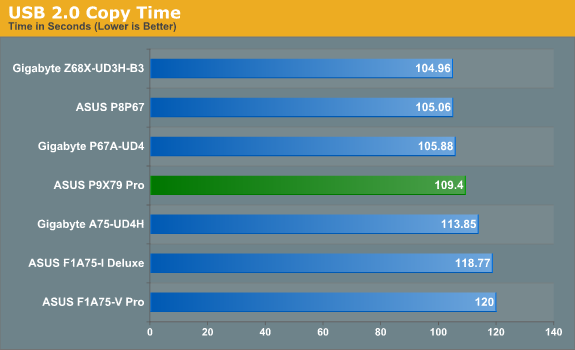
Unfortunately, we ran into an issue with our USB 3.0 stick after the USB 2.0 tests. For some reason it is no longer being detected properly. When we get a replacement, the graphs shall follow.
SATA Testing
We also use CrystalDiskMark for SATA port testing. The operating system is installed on the Micron RealSSD C300, which is rated at 355 MB/s read and 215 MB/s write, and the sequential test is run at the 5 x 1000 MB level. This test probes the efficiency of the data delivery system between the chipset and the drive, or in the case of additional SATA ports provided by a third party controller, the efficiency between the controller, the chipset and the drive.
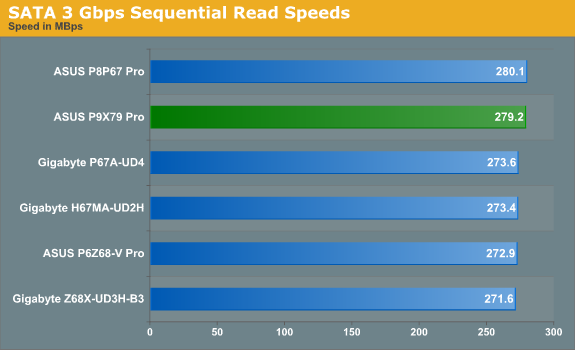
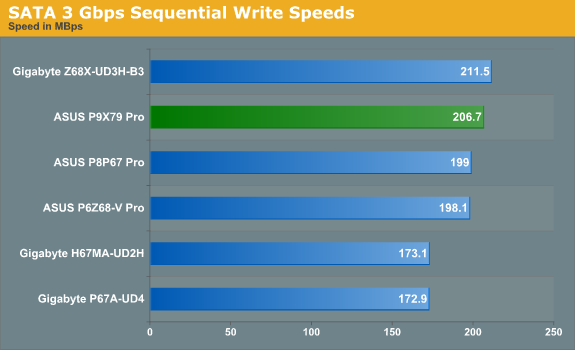
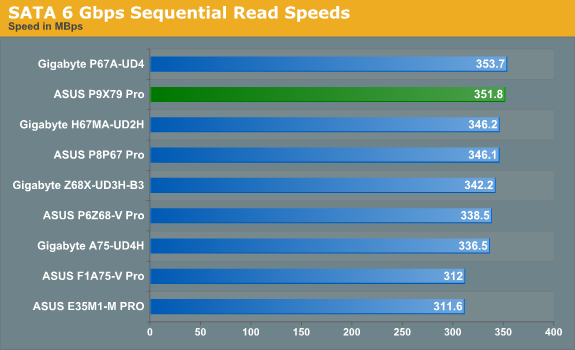
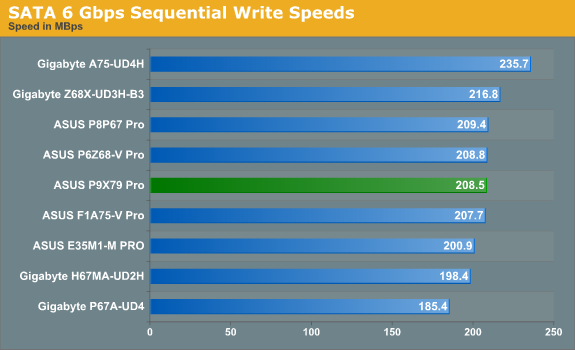
Overall, the PCH does well in SATA sequential speeds compared to previous platforms.
DPC Latency
Deferred Procedure Call latency is a way in which Windows handles interrupt servicing. In order to wait for a processor to acknowledge the request, the system will queue all interrupt requests by priority. Critical interrupts will be handled as soon as possible, whereas lesser priority requests, such as audio, will be further down the line. So if the audio device requires data, it will have to wait until the request is processed before the buffer is filled. If the device drivers of higher priority components in a system are poorly implemented, this can cause delays in request scheduling and process time, resulting in an empty audio buffer – this leads to characteristic audible pauses, pops and clicks. Having a bigger buffer and correctly implemented system drivers obviously helps in this regard. The DPC latency checker measures how much time is processing DPCs from driver invocation – the lower the value will result in better audio transfer at smaller buffer sizes. Results are measured in microseconds and taken as the peak latency while cycling through a series of short HD videos - under 500 microseconds usually gets the green light, but the lower the better.

As with the faster processor, we are expecting better DPC Latency as long as the system is engineered quickly. Our max result here was 116 microseconds, however this was a blip - for most of the time, the board would hover around 30 microseconds, which is an excellent result.










55 Comments
View All Comments
RegGam - Monday, November 14, 2011 - link
SSD caching looks like a killer feature. It seems like it's the key new feature this year. But, I am surprised that ASUS chose not to use Intel SRT. Any idea why? Or, is this a rebranded solution from NVELO?Also, I don't get why the "SSD Cache" ports are 3Gb/s SATA. All the new SSDs will be 6Gb/s so shouldn't the 6Gb/s ports be dedicated to caching? Or, let me choose!
ASUSTechMKT - Monday, November 14, 2011 - link
SRT is not supported natively on the PCH for X79 as such we phased in our ASUS SSD Caching implementation. To clarify the SATA controller used does offer SATA6G support.RegGam - Monday, November 14, 2011 - link
That's great news. (article should be updated). So, I can use any SSD with any SATA 3G or 6G port. So, when can we see a comparison of intel SRT against this solution? And, if it's not Dataplez, compare against that too.Also, when will this be available in Europe (France)?
RegGam - Monday, November 14, 2011 - link
Aww sh!t, just looked at the snapshots. It's a Marvell controller feature. If its the same as their hyperduo junk, I'm no longer interested. Thats not even real caching, just concatenation. I was so excited too. :-(ASUSTechMKT - Wednesday, November 16, 2011 - link
Actually it is the same as SRT which and in realworld performance compairson you acheive the same improved results ( reduced boot times, significantly faster read performance, imporved application response. There is also the advantage compared to SRT that you are no limited on the cache volume size.Overall it is a solid implementation and the cool part is you can still locally run a primary volume and then have your secodary volume ( storage be cached.
mailman65er - Friday, November 18, 2011 - link
> Actually it is the same as SRTHardly... that so-called "caching" feature based on the Marvell (I think they call it hyber duo), does not even perform real caching - its already been exposed. junk... fail...
use SRT or dataplex...
CodeToad - Friday, December 2, 2011 - link
I think you are incorrect on this. Yes, there are two Marvell ports stated to run at 6G. Like you I'd never use that. But there are two 6G ports available on the main, and not Marvell.chrone - Monday, November 14, 2011 - link
with that hefty price, i wonder no dual LAN teaming support. :PASUSTechMKT - Wednesday, November 16, 2011 - link
Cost we phased in a number of more readily useable options than dual lan ( which is only used by a very small % ( of course we do have it on two other boards Deluxe and WS which even features dual Intel lan ).Keep in mind things like 6 pwm fan headers with advanced control for 5 of those headers means a higher bom cost to put the header , the super I/O controller and other aspects little items like this all add up and you have to make the calls on what to phase in over what not to.
wharris1 - Monday, November 14, 2011 - link
I wonder why the 2600 was not used as a comparison CPU for the multithreaded benchmarks in lieu of the 2500.